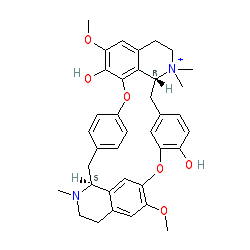GtoPdb is requesting financial support from commercial users. Please see our sustainability page for more information.
|
Synonyms: (+)-tubocurarine | d-tubocurarine
tubocurarine is an approved drug (FDA (1945))
Compound class:
Natural product
Comment: Tubocurarine is a skeletal muscle relaxant. The structure as specified by the FDA and the INN document shows the compound in complex with chloride (see PubChem CID 9917490). As our data specifies the parent compound, it is this structure we have chosen to display here, and which the majority of entries linked to from the table above display.
Ligand Activity Visualisation ChartsThese are box plot that provide a unique visualisation, summarising all the activity data for a ligand taken from ChEMBL and GtoPdb across multiple targets and species. Click on a plot to see the median, interquartile range, low and high data points. A value of zero indicates that no data are available. A separate chart is created for each target, and where possible the algorithm tries to merge ChEMBL and GtoPdb targets by matching them on name and UniProt accession, for each available species. However, please note that inconsistency in naming of targets may lead to data for the same target being reported across multiple charts. ✖ |
|
|||||||||||||||||||||||||||||||||||
| References |
|
1. Bonhaus DW, Stefanich E, Loury DN, Hsu SA, Eglen RM, Wong EH. (1995)
Allosteric interactions among agonists and antagonists at 5-hydroxytryptamine3 receptors. J Neurochem, 65 (1): 104-10. [PMID:7790853] |
|
2. Brady CA, Stanford IM, Ali I, Lin L, Williams JM, Dubin AE, Hope AG, Barnes NM. (2001)
Pharmacological comparison of human homomeric 5-HT3A receptors versus heteromeric 5-HT3A/3B receptors. Neuropharmacology, 41 (2): 282-4. [PMID:11489465] |
|
3. Davies PA, Wang W, Hales TG, Kirkness EF. (2003)
A novel class of ligand-gated ion channel is activated by Zn2+. J Biol Chem, 278 (2): 712-7. [PMID:12381728] |
|
4. Gorboulev V, Ulzheimer JC, Akhoundova A, Ulzheimer-Teuber I, Karbach U, Quester S, Baumann C, Lang F, Busch AE, Koepsell H. (1997)
Cloning and characterization of two human polyspecific organic cation transporters. DNA Cell Biol, 16 (7): 871-81. [PMID:9260930] |
|
5. Hope AG, Peters JA, Brown AM, Lambert JJ, Blackburn TP. (1996)
Characterization of a human 5-hydroxytryptamine3 receptor type A (h5-HT3R-AS) subunit stably expressed in HEK 293 cells. Br J Pharmacol, 118 (5): 1237-45. [PMID:8818349] |
|
6. Ishii TM, Maylie J, Adelman JP. (1997)
Determinants of apamin and d-tubocurarine block in SK potassium channels. J Biol Chem, 272 (37): 23195-200. [PMID:9287325] |
|
7. Jäger H, Adelman JP, Grissmer S. (2000)
SK2 encodes the apamin-sensitive Ca(2+)-activated K(+) channels in the human leukemic T cell line, Jurkat. FEBS Lett, 469 (2-3): 196-202. [PMID:10713270] |
|
8. Kohler M, Hirschberg B, Bond CT, Kinzie JM, Marrion NV, Maylie J, Adelman JP. (1996)
Small-conductance, calcium-activated potassium channels from mammalian brain. Science, 273 (5282): 1709-14. [PMID:8781233] |
|
9. Shah M, Haylett DG. (2000)
The pharmacology of hSK1 Ca2+-activated K+ channels expressed in mammalian cell lines. Br J Pharmacol, 129 (4): 627-30. [PMID:10683185] |
|
10. Strøbaek D, Jørgensen TD, Christophersen P, Ahring PK, Olesen SP. (2000)
Pharmacological characterization of small-conductance Ca(2+)-activated K(+) channels stably expressed in HEK 293 cells. Br J Pharmacol, 129 (5): 991-9. [PMID:10696100] |
|
11. Terstappen GC, Pula G, Carignani C, Chen MX, Roncarati R. (2001)
Pharmacological characterisation of the human small conductance calcium-activated potassium channel hSK3 reveals sensitivity to tricyclic antidepressants and antipsychotic phenothiazines. Neuropharmacology, 40 (6): 772-83. [PMID:11369031] |
|
12. Wenningmann I, Dilger JP. (2001)
The kinetics of inhibition of nicotinic acetylcholine receptors by (+)-tubocurarine and pancuronium. Mol Pharmacol, 60 (4): 790-6. [PMID:11562442] |
|
13. Wittekindt OH, Visan V, Tomita H, Imtiaz F, Gargus JJ, Lehmann-Horn F, Grissmer S, Morris-Rosendahl DJ. (2004)
An apamin- and scyllatoxin-insensitive isoform of the human SK3 channel. Mol Pharmacol, 65 (3): 788-801. [PMID:14978258] |
|
14. Yan D, Pedersen SE, White MM. (1998)
Interaction of D-tubocurarine analogs with the 5HT3 receptor. Neuropharmacology, 37 (2): 251-7. [PMID:9680250] |








